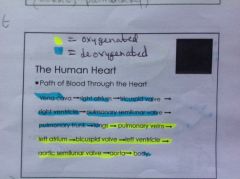![]()
![]()
![]()
Use LEFT and RIGHT arrow keys to navigate between flashcards;
Use UP and DOWN arrow keys to flip the card;
H to show hint;
A reads text to speech;
34 Cards in this Set
- Front
- Back
|
What colour is oxygenated blood? |
BRIGHT RED |
|
|
What are the THREE types of blood vessels? |
1. Arteries & Arterioles 2. Capillaries 3. Veins & Venules |
|
|
What is the function of ARTERIES? |
To carry blood away from the heart to capillaries |
|
|
What is the function of CAPILLARIES?
|
To permit the exchange of materials (especially gasses like O2 & CO2) between blood and tissue |
|
|
What is the function of VEINS?
|
To carry blood from the capillaries toward the heart |
|
|
True or False: Arteries contain valves to ensure unilateral flow of blood. |
FALSE: Veins contain valves. |
|
|
What is the name of the largest ARTERY in the body? |
The AORTA |
|
|
What is the name of the largest VEIN in the body?
|
The VENA CAVA |
|
|
What is the path of blood through the heart? |

|
|
|
Which blood vessel connects arterioles to venules? |
CAPILLARIES |
|
|
True or False: Arteries have higher blood pressure than veins |
TRUE |
|
|
What is the average blood pressure? |
120/80 |
|
|
What is an average cardiac volume? |
75-80 |
|
|
Why is the human heart described as a double pump? |
1. The Right Ventricle sends deoxygenated blood into the pulmonary circuit 2. The Left Ventricle sends oxygenated blood into the system circuit |
|
|
True or False: Blood must travel through the lungs to go from the left side of the the heart to the right side. |
FALSE: Blood flows from the right side of the heart, through the lungs and then to the left side. |
|
|
What are the names of the cardiovascular system's TWO circuits? |
1. The Pulmonary Circuit (through lungs) 2. The Systemic Circuit (through rest of body) |
|
|
What sound does the heart make? |
"Lub-Dub" or "Lup-Dup" |
|
|
What makes the "Lub/Lup" sound in the heart? |
The sound of blood splashing against closed atrioventricular valves, caused by contracted ventricles (ventricular systole). |
|
|
What makes the "Dub-Dup" sound in the heart?
|
The sound of blood splashing against closed semilunar valves, caused by relaxed ventricles (diastole ).
|
|
|
In what form is blood pressure expressed? |
Systolic "over" Diastolic (120/80) |
|
|
True or False: Blood pressure is highest in the venous vessels and lowest in the arterial vessels. |
FALSE: Blood pressure is highest in the arterial vessels and lowest in the venous vessels. |
|
|
True or False: A blood pressure of reading of 145/90 is considered hypotension. |
FALSE: A blood pressure of 145/90 is considered mild hypertension (Stage 1) |
|
|
How many chambers are there in the human heart? |
FOUR |
|
|
What are the names of the human heart's chambers? |
1. Right Atrium 2. Right Ventricle 3. Left Atrium 4. Left Ventricle |
|
|
Which stage of coronary artery disease is often without symptoms? |
CARDIAC ISCHEMIA (The Silent Killer) |
|
|
What is blood composed of? |
1. Plasma (liquid portion of blood) 2. Red Blood Cells (Erythrocytes) 3. White Blood Cells (Leukocytes) 4. Platelets |
|
|
Approximately how many days do Red Blood Cells last? |
120 Days |
|
|
Which to organs destroy Red Blood Cells? |
The Liver and the Spleen |
|
|
What is hemoglobin? |
A red iron-containing pigment found in red blood cells. (Heme portion binds oxygen and carbon dioxide). |
|
|
True or False: Anemia means having too many Erythrocytes? |
FALSE: Anemia means having too few Red Blood Cells/Erythrocytes. |
|
|
True or False: White Blood Cells (Leukocytes) unlike Red Blood Cells are nucleated, lack hemoglobin, fight infection and provide immunity |
TRUE |
|
|
Which component of blood initiates clotting at the site of a wound? |
PLATELETS |
|
|
What is Hemophilia? |
Too few clotting factors |
|
|
What is the main difference between a Red Blood Cell and a White Blood Cell? |
RBC's carry oxygen and WBC's fight infection |

